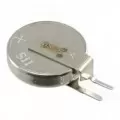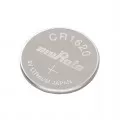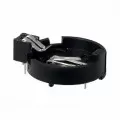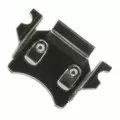OUTLINE:
Button Battery Sizes: A Specialized Guide to Various Types
 197
197The small button batteries we use now are really everywhere, even watches and remote controls can't do without them. The problem is that there are so many battery models and sizes, and it's really difficult to pick them up. But don't worry, I have a fantastic 'button battery model decoding secret' here.
Image Source: Wikipedia.com
In this cheat book, we will unveil the mysterious veil of different models of button batteries one by one, see what their unique features are, and which small gadgets they are most suitable for. When you follow me all the way, I guarantee that when you choose batteries for devices in the future, your mind will be clear and you will never be flustered again.
Let's work together to figure out the twists and turns of these batteries, and see how each type of battery meets our various electricity needs
A preview: Why Do You Need Different Button Battery Sizes
Why do we need different sizes of button batteries? In fact, the size of these batteries is designed to meet the different needs of various devices.
Each type of battery has its own specific voltage and capacity, ensuring that small devices such as watches and remote controls can function properly.
If you can understand these different sizes, it will be easier to choose the right battery and improve the performance and lifespan of the device.
Moreover, using appropriate batteries can also prevent equipment damage or efficiency decline, so it is very important to understand the size of these batteries!
Various Types of Button Battery Sizes [Reference]
|
Diameter (mm) |
Height (mm) |
Voltage |
Capacity (mAh) |
Composition |
Common Applications |
|---|---|---|---|---|---|
|
7.9 |
5.4 |
1.5V |
40-50 |
Alkaline, Zinc Air |
Watches, toys, remote controls |
|
11.6 |
5.4 |
1.5V |
150-200 |
Alkaline, Lithium |
Calculators, digital cameras, toys |
|
10 |
2.5 |
3V |
30-40 |
Lithium |
Key fobs, medical devices, small electronics |
|
12 |
1.6 |
3V |
50-80 |
Lithium |
Watches, calculators, fitness trackers |
|
16 |
3.2 |
3V |
220-240 |
Lithium |
Watches, car keys, fitness devices |
|
20 |
3.2 |
3V |
210-240 |
Lithium |
Computer motherboards, remote controls |
|
24 |
5 |
3V |
500-600 |
Lithium |
Smart devices, IoT devices |
List of 5 Top Manufacturers of button battery
Image Source: Naccon Power Technology
1.Panasonic - Hey, Panasonic, as we all know, the big brother in the battery industry, always likes to come up with new ideas. Their button batteries come in various types including lithium, alkaline, and silver oxide, with sufficient energy and can last for a long time. Whether you are looking for batteries for watches, cameras, hearing aids, or medical devices, Panasonic can provide you with reliable choices.
2.Energizer - Have you heard of the name Energizer? The star of the battery industry! They have a wide range of button batteries, including alkaline and lithium ones. The key is that the battery is durable and not prone to leakage, making your device run smoothly. The remote control, electronic toys, and daily small appliances at home, as well as the Kingdee battery, are all frequent visitors.
3.Duracell - When it comes to DuPont batteries, it is synonymous with durability. Their button batteries are also alkaline and lithium, with sufficient power and designed to be leak proof. Take a look at the electronic toys, digital cameras, and the ones that many people use at home, many of which are powered by DuPont batteries.
4.Sony - Sony, that's a tech giant with top-notch manufacturing. Their button batteries are lithium, alkaline, and high-performance, designed specifically for modern electronic devices. Cameras, watches, compact electronic products, and Sony batteries are all regulars. If you pursue quality and performance, Sony is definitely your favorite.
5.Varta - Varta is also a well-known name in the battery industry, with a focus on quality and environmental protection. Their button batteries come in various types, including alkaline and lithium, and have excellent performance when used on various devices. Watches, calculators, automotive systems, medical equipment, and Walther batteries are reliable choices that can be trusted by both home use and professionals.
How Do you Determine the Correct Button Battery Size for your Device
1.Grab the Device Manual
First, flip through your device's user manual or those papers that came with it. It usually tells you exactly what kind and size of battery you need.
2.Peek at Battery Labels
If your device has a battery compartment, pop out the old battery and check for any writing on it. There's usually a code (like CR2032 or LR44) that'll help you find the right replacement.
3.Measure the Battery Yourself
If there's no label or you've lost the manual, you can measure the battery's width and height using a caliper or even a ruler. Then, compare those numbers to standard battery sizes.
4.Check Manufacturer's Info
Head to the manufacturer's website or call their customer service to get the specifics on what battery your device model needs.
5.Use the Internet
Tons of websites and stores have guides to help you match your device to the right battery size. Just search for your device model along with "battery size" for quick help.
6.Make Sure It's Compatible
When picking a new battery, make sure it fits your device's voltage and other requirements. Putting in the wrong battery could mess up your gadget.
7.Think About the Type
Some devices need specific types of batteries (like alkaline, lithium, or silver oxide). This can affect how well your device works and how long the battery lasts. So, make sure you get the right type too.
Key Differences between Lithium, Silver oxide, and Alkaline Button Battery Sizes
let's break down the main differences between lithium, silver oxide, and alkaline button batteries in a more chatty way:
Chemistry and Voltage Stuff
Lithium: These usually run at 3V and are known for packing a lot of energy and lasting a super long time on the shelf.
Silver Oxide: These are typically 1.55V and give a nice, steady voltage with a lot of power in a tiny package.
Alkaline: These are usually 1.5V and you can find them everywhere, but they don't stay fresh as long as lithium ones.
How Much Power and How Well They Work
Lithium: These have more power and are great for gadgets that use a lot of energy, like cameras and fitness trackers.
Silver Oxide: These are perfect for things like watches because they keep a steady voltage and work really well.
Alkaline: These are good for gadgets that don't use much power, like remote controls, but they might struggle with high-energy tasks.
How Long They Stay Good on the Shelf
Lithium: These can last up to 10 years or more, so they're great if you need to store them for a while.
Silver Oxide: These usually last around 3-5 years, depending on the brand.
Alkaline: These stay good for about 5 years, but their performance might drop if you don't use them within a certain time.
How Well They Handle Heat and Col
Lithium: These work great in really hot or cold weather, making them perfect for outdoor gadgets.
Silver Oxide: These do well too, but they might not be as good in super high or low temps.
Alkaline: These tend to struggle more in extreme weather.
What They're Used For
Lithium: These are top-notch for high-performance electronics, medical stuff, and cameras.
Silver Oxide: You'll often find these in watches, calculators, and hearing aids because they keep a steady power output.
Alkaline: These are everywhere in everyday things like toys and remote controls.
Are Smaller Button Batteries Less Powerful than Larger Ones
Image Source: CNN.com
Here’s a explanation of the power differences between smaller and larger button batteries:
Capacity
Smaller Batteries: Lower capacity (e.g., LR41 ~40 mAh), suitable for low-drain devices like watches.
Larger Batteries: Higher capacity (e.g., CR2032 ~210-240 mAh), ideal for high-drain devices like cameras.
Power Output
Voltage: Often similar, but larger batteries can sustain higher discharge rates.
Usage: Small batteries excel in low-drain applications; large batteries support sustained power needs.
Chemical Composition
Energy Density: Lithium batteries may outperform alkaline batteries even in smaller sizes.
Final Verdict
To wrap it up, knowing the special features and uses of different button battery sizes is key to picking the right one for your gadgets. Each size has its own perks, like how much power they hold, their voltage, and what they're best for. By getting to know these differences, you can make sure your electronic toys work their best and last a long time, whether they need a little power or a lot. Choosing the right button battery smartly boosts how well your devices work and how reliable they are.

Disclaimer: The views and opinions expressed by individual authors or forum participants on this website do not represent the views and opinions of Chipsmall, nor do they represent Chipsmall's official policy.

share this blog to:











